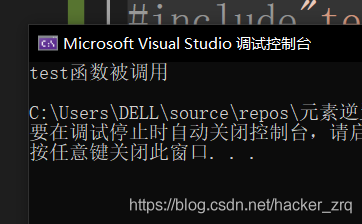这篇文章主要介绍了C++一个函数如何调用其他.cpp文件中的函数问题,具有很好的参考价值,希望对大家有所帮助。如有错误或未考虑完全的地方,望不吝赐教
一个函数调用其他.cpp文件中的函数
使用VC或VS创建C++项目的时候,会自动产生许多文件夹,其中有一个文件夹->源文件:
在该文件下可以自定义许多.cpp文件,但是需要注意的是这里面的各个文件只能有一个文件中含有main()函数,
而且各个文件中不能使用相同的函数名进行定义;
那么要那么多文件放在项目中有什么用呢?
当然这里C++是提供一个文件调用其他文件中函数的功能的,
这就可以让我们自定义一个只包含main()函数的文件,通过在该函数中调用其他文件中的函数就可以将各个文件链接起来,
而且更重要的一点就是,通过调用其他,cpp文件中的函数的时候,如果调用的某函数又调用了它自己文件中的一个函数,
那么只用调用“父级函数”就可以实现间接调用~~~
看示例
首先是资源管理窗口:

功能主函数.cpp
// C++上机作业.cpp : 定义控制台应用程序的入口点。 //'0-9': 48-57 #include "stdafx.h" using namespace std; extern void gotoxy(short x, short y); extern void sort_by_name(); extern int Strtoint(); int main() { system("title 功能主函数"); gotoxy(23, 2); cout << "功能列表"; gotoxy(15, 3); cout << "1:字符串转换为数值类型"; gotoxy(15, 4); cout << "2:对中文字符进行排序"; gotoxy(0, 10); int choice = 0; cout << "请输入您要执行的功能:"; cin >> choice; getchar(); //吸收回车 switch (choice) { case 1: Strtoint(); break; case 2: sort_by_name(); break; default: cout << "选择失败,感谢使用,再见!" << endl << endl; } return 0; }stdafx.h(stdandard application framework extensions)
// stdafx.h : 标准系统包含文件的包含文件, // 或是经常使用但不常更改的 // 特定于项目的包含文件 // #pragma once #include "targetver.h" #include#include #include #include #include //注意这里的string与cstring中的使用差别,在定义与使用cout输出string类型字符串的时候,最好使用string库,否则可能会出现乱码以及错误等一系列错误 // TODO: 在此处引用程序需要的其他头文件
gotoxy().cpp
#include "stdafx.h" using namespace std; void gotoxy(short x, short y) { COORD pos = { x,y }; HANDLE hOut = GetStdHandle(STD_OUTPUT_HANDLE); SetConsoleCursorPosition(hOut, pos); }对中文字符的排序.cpp
//对中文字符串进行排序时,默认是按照第一个字符的第一个拼音的顺序进行排序 #include "stdafx.h" using namespace std; void sort_by_name() { string s[4] = { "一号","二号","三号","四号" }, t; for (int i = 0; i<4; i++) { for (int j = i; j<4; j++) { if (s[i]>s[j]) { t = s[i]; s[i] = s[j]; s[j] = t; } } } for (int i = 0; i <4; i++) { cout << s[i] << endl; } cout << "功能运行结束!" << endl << endl; }字符串转换为数值型.cpp
#include "stdafx.h" using namespace std; int Strtoint_0(const char str[]) //字符串数字转换为整形 { int i = 0, j = 0; long long number1 = 0; //定义一个长整形变量,用来存储转换后得到的值 int number[50] = { 0 }; //定义一个数组,用来存储转换后得到的值 int symbol = 1; //符号常量,0为负,1为正(默认为正) while (str[i] != '\0') //测试输出判断是否正确 { while (str[i] == ' ') { i++; } if ((str[i] == '+' || str[i] == '-')) { i++; if (str[i] == '-') { symbol = 0; } } else if (str[i]<'9' && str[i]>'0') { number[j++] = str[i] - 48; //存储数据,j++ // cout << number[j - 1] << endl; i++; } if (str[i]>'9' || str[i]<'0') //停止输出规则判断语句 { break; } } cout << "数的位数为:" << j << endl; //j到这里就已经得到数组的最大索引值+1了 int x = 1; for (int k = j - 1; k >= 0; k--, x = x * 10) { number1 += number[k] * x; } if (symbol == 0) { number1 = number1*(-1); } cout << "转换后的数为:" << number1 << endl << endl; return 1; } int Strtoint() //调用字符转换函数,确保变量不在主函数中定义 { char arr[50] = { 0 }; int i = 0; char c; cout << "Please input the string :" << endl; while ((c = getchar()) != '\n') { arr[i++] = c; //注意这里下面的i就开始++了 } /* while ((c = cin.get()) != '\n') //另一种控制输入的方法 { arr[i++] = c; cout << arr[i - 1]; } */ Strtoint_0(arr); return 0; }在主文件cpp中调用其他文件函数的方法
直接用
和我们的数据成员必须加extern不同的是,你只需把待调用函数的声明写在其头文件中,然后在主函数中直接用就可以
//test.h #ifndef TEST_H //注意,这里千万不要写成TEST.H,必须用下划线,用点不行 #define TEST_H void print(); #endif //test.cpp #include#include"test.h" using namespace std; void print() { cout << "test函数被调用" << endl; } //main.cpp #include #include"test.h" using namespace std; int main() { print(); }

extern方法
使用extern的时候你甚至不需要在main.cpp文件中加上引用文件的声明,直接就可以用。
#includeusing namespace std; extern void print(); int main() { print(); }
但是这样写其实作用不大,在一些大的工程中反而不如以好用。
总结
以上为个人经验,希望能给大家一个参考,也希望大家多多支持0133技术站。
以上就是C++一个函数如何调用其他.cpp文件中的函数的详细内容,更多请关注0133技术站其它相关文章!






